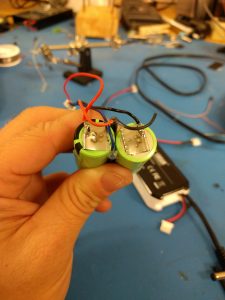Spot Welding Lithium Battery Cells
Tonight we used the spot welder again. We built it several months ago to make the battery pack for Lightning mini-bike. You can see two transformers in the picture. The little one is from a typical microwave oven. The internet was wrong – our milage varied – it was under powered. So we acquired a 36v industrial battery charger to harvest the larger transformer from. Its only slightly overkill. By slightly overkill we mean very much overkill. No seriously. It’s perfectly sized. Read on…
 The components are all there. A transformer – which we removed the secondary windings from and wound our own – 3-1/2 loops of 1/0 welding cable. According to our best measurements, it has an open circuit AC voltage of just under 5 volts. And a dead-short current of – well, the clamp ammeter’s range is 400A; you can trust or dismiss it’s 800A reading. The mains current is 40ish amps. The good news is the 15A circuit breaker likes to over-achieve. Briefly.
The components are all there. A transformer – which we removed the secondary windings from and wound our own – 3-1/2 loops of 1/0 welding cable. According to our best measurements, it has an open circuit AC voltage of just under 5 volts. And a dead-short current of – well, the clamp ammeter’s range is 400A; you can trust or dismiss it’s 800A reading. The mains current is 40ish amps. The good news is the 15A circuit breaker likes to over-achieve. Briefly.
The leads are constructed of 10ga solid core wire screwed to grounding clamps along with the 1/0 secondary cables. Since the open circuit voltage is only 5v, the wood block is quite safe to use as a mount and handle. Yes, it would be better to use a stationary clamp setup – we’ll get there eventually.
Next we have a 12vdc coil relay that switches the mains input to the transformer. It’s rating is greater than the measured current. I think. It is switched on with an Arduino Micro installed onto a surplus custom circuit board that happened to have screw terminals and a MOSFET that was perfect for the task. Oh, it also has a pair of momentary switches soldered into place. This highly sophisticated control system is powered from a generic 12vdc 1.5a wall-wart.
The system is powered by standard 110AC and uses two sockets – one for power to transformer, and one for the Arduino.
We cribbed the Debounce example script from the Arduino software and slightly modified it to only trigger the relay when you press down on the button and only power the relay on for a specified period of time.
 How much time? Well, at several hundred amps of current, not much time. 200 milliseconds was sufficient to blast a hole through our copper strips. 100ms was still popping holes. We settled on 30ms for the final configuration. The tabs are quite well attached.
How much time? Well, at several hundred amps of current, not much time. 200 milliseconds was sufficient to blast a hole through our copper strips. 100ms was still popping holes. We settled on 30ms for the final configuration. The tabs are quite well attached.
